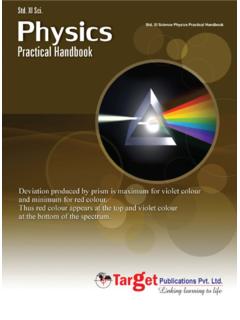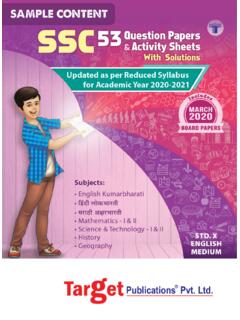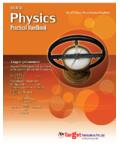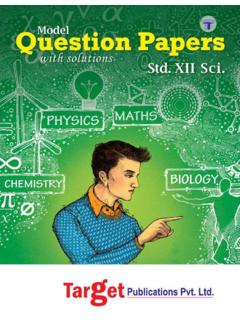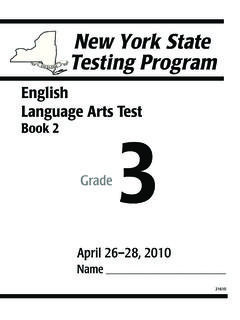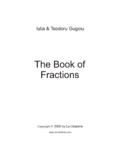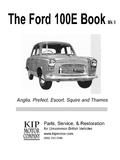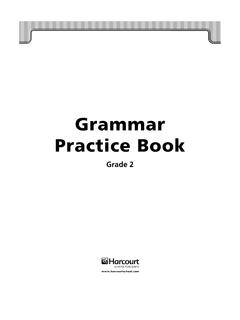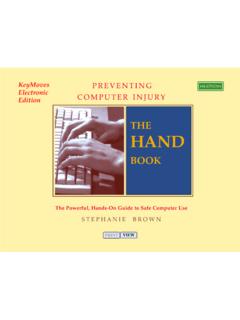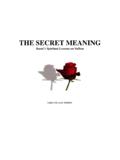Transcription of No part of this book may be reproduced or …
1 No part of this book may be reproduced or transmitted in any form or by any means, ROM/Audio Video Cassettes or electronic, mechanical including photocopying; recording or by any information storage and retrieval system without permission in writing from the Publisher. + STD. XI Sci. Perfect Physics Printed at: Dainik Saamana, Navi Mumbai Written as per the revised syllabus prescribed by the Maharashtra State Board of Secondary and Higher Secondary Education, Pune. TEID : 925 Fifth Edition: June 2015 Salient Features Exhaustive coverage of syllabus in Question Answer Format. Simple and Lucid language. Covers all Textual and intext Questions.
2 Neat, labelled and authentic diagrams. Covers relevant NCERT questions and problems with solutions. Solved & Practice Numericals duly classified. Multiple Choice Questions for effective preparation. Includes features like Brain Teasers and Additional Information. Preface In the case of good books, the point is not how many of them you can get through, but rather how many can get through to you. Std. XI Sci. : PERFECT PHYSICS is a complete and thorough guide critically analysed and extensively drafted to boost the students confidence. The book is prepared as per the Maharashtra State board syllabus and provides answers to all textual and intext questions.
3 Sub-topic wise classified question and answer format of this book helps the student to understand each and every concept thoroughly. Neatly labelled diagrams have been provided wherever required. National Council Of Educational Research And Training (NCERT) questions and problems based on Maharashtra board syllabus have been provided along with solutions for a better grasp of the concept and preparing the students on a competitive level. Definitions, statements and laws are specified with italic representation. Formulae are provided in every chapter which are the main tools to tackle difficult problems. To develop better understanding of concepts, relevant points and questions are discussed in the form of Additional Information.
4 Brain Teasers are theory questions and numericals build within the frame-work of State Board syllabus to develop higher order thinking among students. Solved problems are provided to understand the application of different concepts and formulae. Additional theory questions have been provided to help the student gain insight on the various levels of theory-based questions. Practice Problems and Multiple Choice Questions help the students to test their range of preparation and the amount of knowledge of each topic. Hints have been provided for selected multiple choice questions to help the students overcome conceptual or mathematical hinderances. A book affects eternity; one can never tell where its influence stops.
5 Best of luck to all the aspirants! Contents No. Topic Name Page No. 1 Measurements 1 2 Scalars and Vectors 24 3 Projectile Motion 48 4 Force 77 5 Friction in Solids and Liquids 114 6 Sound Waves 144 7 Thermal Expansion 165 8 Refraction of Light 192 9 Ray Optics 220 10 Electrostatics 250 11 Current Electricity 286 12 Magnetic Effect of Electric Current 310 13 Magnetism 334 14 Electromagnetic Waves 355 Note: All the Textual questions are represented by * mark All the Intext questions are represented by # mark Publications Pvt. Ltd. Target Chapter 01 : Measurements 1 Syllabus Introduction Need for Measurement Unit for Measurement System of Units units Fundamental and derived units Dimensional Analysis Order of magnitude and significant figures Accuracy and errors in measurements Introduction Physics is the branch of science which deals with the study of nature and natural phenomena.
6 There are two domains in the scope of physics: i. Macroscopic domain: The macroscopic domain includes phenomena at the laboratory, terrestrial and astronomical scales. ii. Microscopic domain: The microscopic domain includes atomic, molecular and nuclear phenomena. What are physical quantities? Ans: Those quantities which can be measured , subjected equally to all three elements of scientific study, namely : detailed analysis, precise measurement and mathematical treatment, are called physical quantities. Example: Mass, length, time, volume, pressure, force, etc.
7 Need for Measurement * What is the need for measurement of a physical quantity? Ans: i. To study phenomena in physics, scientists have performed different experiments. ii. These experiments require measurement of physical quantities such as mass, length, time, volume, etc. iii. Based on the observations of these experiments, scientists have developed various laws and theories. iv. For the experimental verification of various theories, each physical quantity should be measured precisely. v. Therefore, accurate measurement of physical quantities with appropriate instruments is necessary. vi. Example: Consider the statement The water boiled after some time.
8 In the given statement, the physical quantity time is not defined precisely. A numerical value for time, which is measured on a watch is necessary. Measurements 01 Publications Pvt. Ltd. Target Std. XI Sci.: Perfect Unit for Measurement The magnitude of a physical quantity x is expressed in the following way: Magnitude of physical quantity = Numerical value of physical quantity Size of its unit. , x = nu where, n = number of times the unit is taken. u = size of unit of physical quantity. Example: If the length of a rod is 5 metre it means that the rod is 5 times as long as the standard unit of length ( , metre).
9 * What is meant by unit of a physical quantity? Ans: i. The reference standard used for the measurement of a physical quantity is called the unit of that physical quantity. ii. Example: Physical Quantity Standard (unit) Length metre, centimetre, inch, feet, etc. Mass kilogram, gram, pound etc. State the essential characteristics of a good unit. Ans: Characteristics of a good unit: i. It should be well-defined. ii. It should be easily available and reproducible at all places. iii. It should not be perishable. iv. It should be invariable. v. It should be universally accepted.
10 Vi. It should be comparable to the size of the measured physical quantity. vii. It must be easy to form multiples or sub multiples of the unit. Note: Choice of unit depends upon its suitability for measuring the magnitude of a physical quantity under consideration. Hence, we choose different scales for same physical quantity. Various units to express a physical quantity: Prefix Symbol Power of 10 Prefix Symbol Power of 10 Exa E 1018 deci d 10 1 Peta P 1015 centi c 10 2 Tera T 1012 milli m 10 3 Giga G 109 micro 10 6 Mega M 106 nano n 10 9 Kilo k 103 angstrom 10 10 Hecto h 102 pico p 10 12 Deca da 101 femto f 10 15 atto a 10 18 System of Units Units are classified as fundamental units and derived units.
